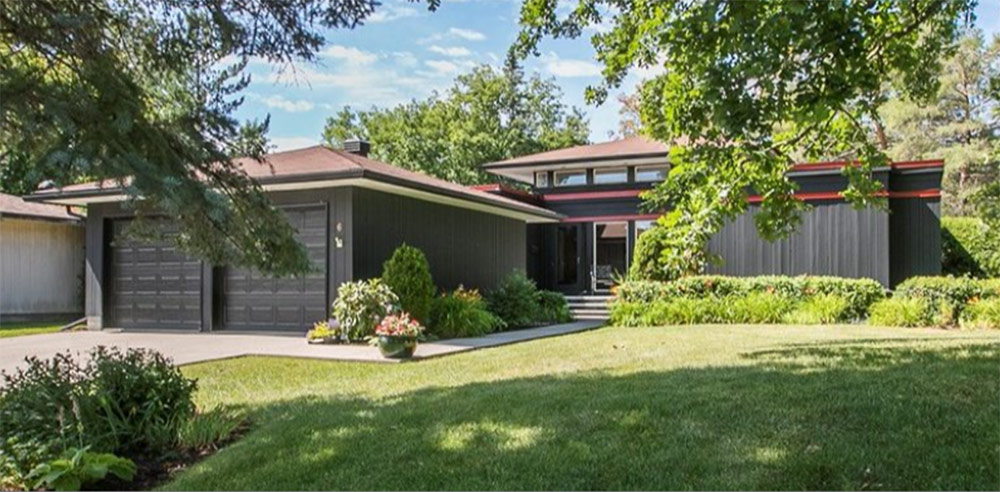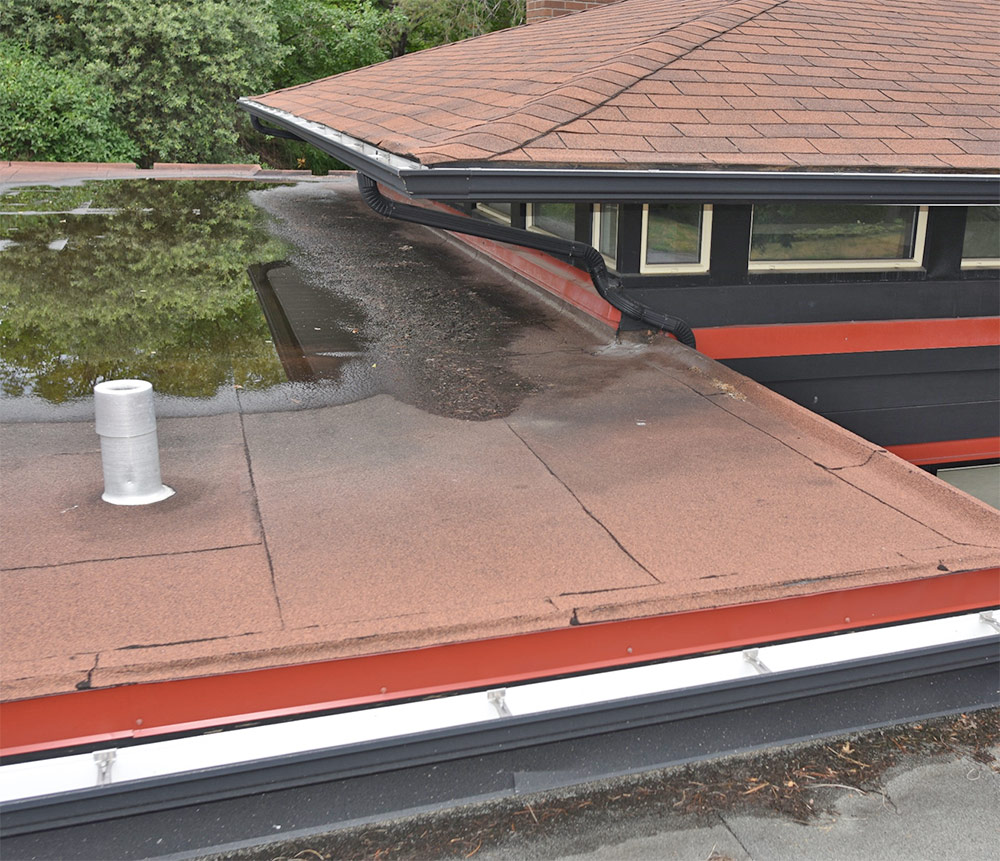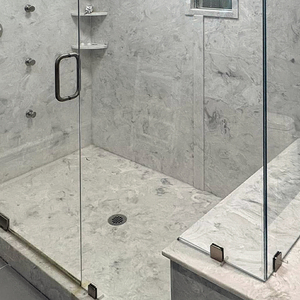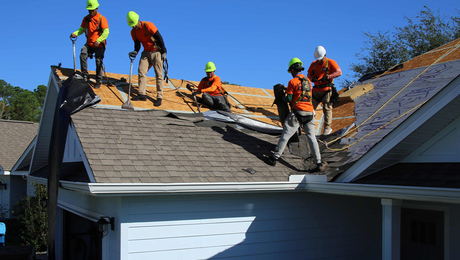Podcast 571: Pooling on Flat Roofs, Irrigation Timers, and Single-Pane Windows
Respirators, Icelandic heat pumps, ponding flat roofs, irrigation timers, and replacing windows.
Follow the Fine Homebuilding Podcast on your favorite app. Subscribe now and don’t miss an episode:
 |
Help us make better episodes and enter for a chance to win an FHB Podcast T-shirt:
www.finehomebuilding.com/podcastsurvey
Andy says beer helps keep craft alive. Evan suggests getting a good respirator. Adam and Hlynur are familiar with Icelandic heat pumps. Mark asks how to redo his flat roof. Pete needs a better irrigation timer. Will wants new windows.
Editor Updates:
- Mark’s welcome back, house update
- Samantha’s plaster/drywall repairs
- Jeff’s deck railing
- Patrick: Join us at the Northeast Building Science Symposium on June 20 and 21 at Two Roads brewery in Stratford, CT. With: Ben Bogie, Jake Bruton, Steve Baczek, Ross Trethewey, Kohta Ueno
Listener Feedback 1:
Andy writes: I’m have one word for Nicole on how to manage the drudgery of working on your own home: BEER. Obviously that’s not an option on the job site, but on your own home have at it.
Thanks, Andy Steele FRS Builders LLC
Listener Feedback 2:
Evan writes: Good afternoon!
I enjoyed y’all’s discussion about how to stay motivated when dredging through projects. I wanted to comment on your discussion about making an investment in a good respirator.
The full-face respirator with air supply is called a powered air purifying respirator (PAPR), if I recall correctly. As a mold assessment consultant, I have several respirators at my disposal that I have invested in over the years. I have a 3M Half Facepiece with P100 particle filters that I commonly use during nasty inspections and a full-face respirator from North that I use every time I am in a crawlspace.
I cannot recommend highly enough the full-face respirator with its impact-resistant plastic face shield. I believe they also make an attachment that will hold your glasses in place inside the mask, which I believe y’all had discussed a as a point of frustration in attic work. Another huge benefit is the wide variety of filters available. If you’re cleaning out decomposing rats and squirrels from an attic or a crawlspace, they make P100 particle filters that also handle organic vapor so you can’t smell a thing!
Finally, these things don’t have to be a budget breaker. You can often find open-box versions of all of these respirators on eBay at half their retail price.
The more I have learned about lung health and the effect of fibers and particulates on our bodies, the more I have become a proponent of wearing a respirator all the time during any remodel work.
Hope this helps! Cheers!
Evan Bache-Wiig, All Mold Pro
Related Links:
Listener Feedback 3:
Adam in Fort Smith, Northwest Territories Canada, writes: Hi FHB gang,
The Icelandic word for geothermal energy is actually not too hard for English speakers: Jarðhitaorka. The word for a geothermal power plant is Jarðvarmavirkjun. The letter ð (eth) is pronounced similarly to “th” in English. If you are ever visiting Iceland, I highly recommend checking out Hellisheiðarvirkjun. The power plant just outside of Reykjavik is very impressive and has a great interpretive center.
I am not sure if there is a word for ground-source heat pumps. Pretty much everyone heats their homes with radiators that use hot water supplied by the local power plant or baseboard heaters as electricity is very cheap. It is so cheap that many of the Icelanders I know keep a window cracked open year-round for fresh air. This may also be a holdover from when most people heated their homes and cooked their meals by burning peat moss, which would dramatically reduce the indoor air quality. To this day, most homes have a place outside where kids sleep because of this.
Love the show and thanks for the excuse to procrastinate on my renovations for a bit.
Related Links:
- GBA.com: A Fresh Look at Ground-Source Heat Pumps
- GBA.com: Is a Ground-Source Heat Pump a Renewable Energy System?
Listener Feedback 4:
Hlynur writes: Hello FHB crew,
I am writing to you from Reykjavik, Iceland. In 2020, when faced with the task of renovating a condo we had just purchased as an office worker who had never really swung a hammer before, I started looking for resources on how to proceed with the job. I stumbled upon the Fine Homebuilding Podcast. While I find most of the discussion on the show doesn’t really seem to apply to the Icelandic styles or methods of building—we have horizontal rain 50% of the time, snow the rest—I found the extremely entertaining crew and interesting discussions too enjoyable to let go of. I embarked on the journey of gutting and renovating a condo mostly by myself, learning by doing along the way, all the while having the support of the FHB crew in my ears through the blood, sweat, swearing, and tears.
In episode 565 you called for the Icelandic word for “geothermal,” and I may finally be of some assistance. The word for geothermal is “jarðhiti”—pronounced “yarth hiti”—where hiti is pronounced like the tool brand Hilti (without the L), or like “hit” with an I at the end. Attached is an audio file for your reference:
Audio PlayerA heat pump is a “varmadæla,” I’ll have you figure out the pronunciation for yourselves.
Thank you for keeping me sane with your lively discussions during the hundreds of hours I’ve put into my renovation work. I have many fond memories toiling away on something with the crew in my ears.
Regards,
Hlynur T. (that’s pronounced like “cleaner”)
Part time DIY-er
P.S. It can’t have been all that bad as I now have come into possession of a cabin in the countryside that needs way more work than the condo. I must have caught some bug.
PPS. What the heck is a “crawlspace,” and why wouldn’t you just make it a “standing-up space” instead?? Easier to work on.
Related Links:
Question 1: What’s the best way to retrofit a flat roof?
Mark writes: Dear Fine Homebuilding podcast crew and esteemed listeners,
We need your help! Buckle up – this is a long one.
We purchased a 1970 mid-century bungalow in Ottawa, Ontario (ASHRAE Climate Zone 6) in 2019. The home has a central clerestory section with 15-ft.-high ceilings covered by a hipped roof. On either side of the central section are 8-ft.-high wings with flat roofs. We fell for the architecture when we bought the home, but, sadly, have come to learn that many of these charming design details probably don’t make sense in our climate.
We’re planning a deep retrofit that we’ll tackle in phases. Our first priority is dealing with the existing flat roofs. We want to insulate, air-seal, and slope them before re-roofing. Oh, and there’s currently no overhang, so we’d like to add overhangs to protect the walls that we’ll retrofit by insulating on the exterior at a later date. We need to replace the flat roofing (the current modified-bitumin roofing is estimated to be over 25 years old). There are scuppers cut at the back of the parapet, but the roof has no slope (in fact it sags in the middle), so surprise, surprise, it doesn’t drain.
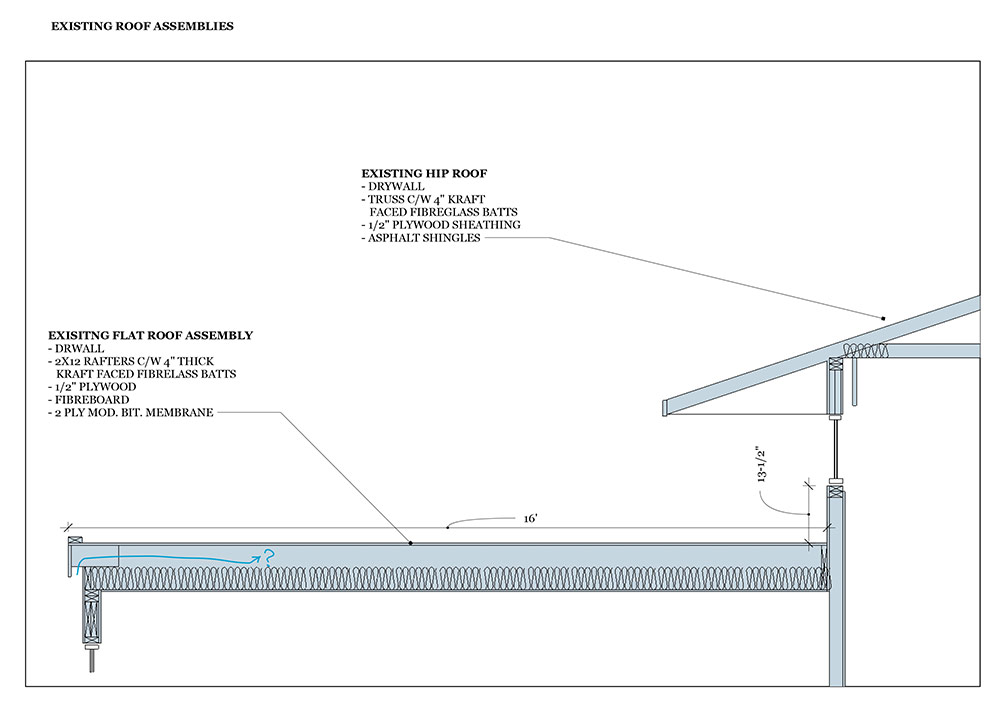
It would be pretty straightforward to add sloped insulation above the roof sheathing but our challenge will be the fact that the flat roofs die into the sidewall of the glazed clerestory. The sill of the windows is about 13 in. above the finished roof, limiting how much we can build up the assembly.
I should note that the clerestory windows are protected by 40-in.-deep overhangs. In the four winters we’ve lived in the house, we haven’t seen any snow accumulate under the windows, so I’m not sure how important it is to have clearance under the windows.
The way I see it, we have two retrofit options:
- Leave the existing ½-in. plywood in place.
- Install a self-adhered air barrier and temporary WRB over it.
- Install 2% sloped graphite-infused EPS over it (5 1/2-in.-thick at the sidewall, tapering to 1 1/2 in. at the eave)
- Install 2×4 rafter on top of the foam to give us a 16-in. overhang and solid framing for potential future PV attachment.
- Fill the rafter cavities with mineral wool.
- Install sheathing and new flat roofing membrane base and cap sheets.
This option would do away with the venting and give us a hot roof with around R-30 at the eave (which is the minimum we need outboard of the sheathing to avoid condensation) and R-50 at the sidewall. We’d have about 5” of clearance under the clerestory windows. The upfront emissions with this approach would be about 1.3 T CO2e (calculated using NRCan’s Material Emission Calculator).
- Remove the existing sheathing and fill the rafter cavities with 2-lb. closed-cell HFO polyurethane spray foam.
- Reinstall sheathing.
- Install a self-adhered air barrier and temporary WRB over it.
- Install 2% sloped graphite-infused EPS over that (same thicknesses… 5 1/2-in.-thick at the sidewall, tapering to 1 1/2-in. at the eave).
- Frame overhang ladders flush with the existing roof plane and apply them to the existing rafter rim.
- Install new flat roofing membrane.
This option would also be a hot roof with a higher R-value (R-50-70), reduced risk of condensation, and more clearance under the clerestory windows (~8 in.). But it would involve materials with a higher carbon footprint (5.7 T CO2e). Plus, we’d make it a nightmare for someone who may want to replace the drywall in the future, as the whole ceiling would be basically glued together with spray foam.
What would you do? Are we overlooking another brilliant solution? Could we put a bond break into the rafter cavities to keep the spray foam from adhering to the drywall?
Looking forward to your perspectives. Love the podcast. Keep up the great work.
Thanks a million!
Mark
Notes:
To put the embodied or material emissions into perspective, the house currently emits about 7.25 tons of CO2e per year. The goal is to get this to zero by 2030. But, of course, it’s hard to bake a cake without breaking a few eggs!
Related Links:
- 5 Ways to Insulate a Flat Roof
- Replacing PVC With an EPDM Membrane on a Flat Roof
- Modified-Bitumen Flat Roofs
Question 2: Is there a way to install a timer indoors for my irrigation system?
Pete writes: Hello FHB pod,
Your favorite bearded interior designer again from Caledonia, Ontario, Canada. It’s spring again, and I pulled out our outdoor programmable water timer for the garden beds this week. Ours is the Orbit Single Outlet.
It doesn’t seem to matter which manufacturer you choose—same concept, different colored hunk of plastic. I know the connections are outside, but we all know threaded plastic fittings under constant water pressure are bad news. No matter how much Teflon wrap you use, they always seem to leak.
This got me wondering, are there any programmable indoor water valves? Or even an electronic valve that I could plug into a timer? This would be less susceptible to frost and likely way more reliable. I can split water lines outside after a frost-free/air-purge hose bib outside. Bonus points if you can find one that ties into PEX, because I can’t seem to find one.
I have been bingeing the podcast from the start. Thanks for keeping it up. I most certainly appreciate the information and wide range of feedback
Pete B.I.D, NCIDQ, ARIDO
Senior Interior Designer
From Mike Lombardi,
Patrick,
I don’t have a ton of experience with irrigation system valves, timers, controllers, etc., but I do know there are solid brass programmable solenoid valves/timers with NPT connections that could easily be fitted with PEX adapters. The writer mentioned Teflon tape, which is not needed for hose bib-companion nut connections, and in some cases can impede a successful mating attempt. There are millions of these types of connections that are under continuous pressure that don’t leak—washing machines, for example.
While the male thread on a hose bib is close to 3/4-in. NPT, it is not tapered or deep and has a different thread pitch than NPT.
Garden-hose thread is officially referred to as “national hose” (sometimes abbreviated as MHT & FHT for male & female).
We come across quite a few plastic, leaking GH connections. Most often the leak is the result of a poor-quality washer. I prefer a supple but firm, flat rubber washer that will seal and push back as it makes up. Many times, hard plastic washers come with devices, and they don’t seal well, especially under the influence of high water pressure and water hammer.
Water quality, or lack of it, can affect washer and companion-nut integrity. Chemicals used to treat public water sometimes can erode and corrode; high concentrations of salt, chlorides, and chlorine can really affect non-brass metal fittings and nuts.
Sometimes an irrigation timer valve will benefit from a water hammer arrestor installed somewhere upstream. This depends on the water source, water pressure, solenoid valve shut-off frequency and timing, etc.
There is so much plastic in this modern world. It has infiltrated every aspect of building and the building trades including maintenance, installation, and repair. Technology has helped plastic products improve in their quality and reliability.
ASCO makes several types and sizes of brass-body, 120-volt solenoid valves that could easily be wired in series with a digital programmable timer.
I hope this helps, and thanks for staying in touch!
Related Links:
Question 3: What are the best triple-pane replacement windows?
Will writes: Hi folks,
I wanted to follow up on my email that was addressed, sort of, on a recent podcast. I live outside of Boston in zone 5. Again, I’m trying to figure out the best way to replace my awful 1970s aluminum, single-pane replacements (with storms) in a 1920s bungalow. The age-old saying in building science that “windows are last” may be true for many houses, but I’ve done a lot of air-sealing and fully electrified, and the leakiest part of the envelope is currently the windows. They are also terribly uncomfortable. Don’t tell me I don’t need to replace them! There are incentives to replacing single-panes with triple. So which triple-pane window should I choose, and who can do the replacement? It’s impossible to find good people to do proper work these days who actually read FHB and understand flashing, etc. There should be a “I subscribe to FHB certification” so you know when you’re getting quality folks.
Best,
Will
Related Links:
- Tough Choice: Double-Pane vs. Triple-Pane Windows
- GBA.com: What Windows Should I Buy?
- GBA.com: The Road Ahead for Insulating Glass
END NOTE:
Podcast 569: Members-only Aftershow — Mark’s Petersen’s New House
The crew talks to Mark about building a house during the height of a pandemic outbreak, choosing materials and finishes for your own home, and adjusting to rural living.
Check out one of our latest Project Guides: Energy Retrofit!
Check out our FHB Houses:
Visit the Taunton Store • Magazine Index • Online Archive • Our First Issues • All Access
Help us make better episodes and enter for a chance to win an FHB Podcast T-shirt: www.finehomebuilding.com/podcastsurvey

If you have any questions you would like us to dig into for a future show, shoot an email our way: [email protected].
If we use your question we’ll send you a FHB Podcast sticker!
FHB Podcast T-shirts!
Represent your favorite podcast! Available in several styles and colors. Made from 100% cotton. Find the Podcast t-shirt and more cool products in the Fine Homebuilding Store.
| Fine Homebuilding podcast listeners can now get 20% off anything in the Taunton store, including Pretty Good House.
Use the discount code FHBPODCAST to take advantage of this special offer. |
 |
“Finally, knowledgeable people talking about building reasonably-sized, high-performance houses for normal people with real budgets!” — DanD, VA, 8/19/22, Amazon.com review |
We hope you will take advantage of a great offer for our podcast listeners: A special 20% off the discounted rate to subscribe to the Fine Homebuilding print magazine. That link goes to finehomebuilding.com/podoffer.
The show is driven by our listeners, so please subscribe and rate us on iTunes or Google Play, and if you have any questions you would like us to dig into for a future show, shoot an email our way: [email protected]. Also, be sure to follow Fine Homebuilding on Instagram, and “like” us on Facebook. Note that you can watch the show above, or on YouTube at the Fine Homebuilding YouTube Channel.
The Fine Homebuilding Podcast embodies Fine Homebuilding magazine’s commitment to the preservation of craftsmanship and the advancement of home performance in residential construction. The show is an informal but vigorous conversation about the techniques and principles that allow listeners to master their design and building challenges.
Other related links
-
- All FHB podcast show notes: FineHomebuilding.com/podcast.
- #KeepCraftAlive T-shirts and hats support scholarships for building trades students. So order some gear at KeepCraftAlive.org.
- The direct link to the online store is here.
